We have listed the most frequently asked questions about our Bichamp products.
Please feelfree to contact our customer service if your have any further questions.
How long can I store a band saw blade? +
The key factors in maintaining the blade's condition include:
a. Environment:Store the blade in a cool,dry place to prevent rust and corrosion.Avoid areas with high humidity or extreme temperatures.
b. Packaging:Keep the blade in its original packaging or wrap it in a protective material like rust-inhibiting paper.
c. Position:Store the blade flat or on a proper rack to prevent bending or warping.Avoid placing heavy objects on top of it.
d. Check Regularly:Periodically inspect the blade for any signs of rust or damage.
If you follow these guidelines,a band saw blade can remain in good condition for several years.However,it's always a good idea to inspect it for any issues before using it,especially if it has been stored for a long time.
What factors impact on the life of band saw blade? +
1. Material Type
Different materials require specific blade types and configurations.For example,bimetal blades are suitable for a variety of metals,while carbide or diamond-studded blades are better for very hard materials.
2. Cutting Speed and Feed Rate
Adjust the speed and feed rate according to the material being cut.Too high a speed or feed rate can cause excessive wear and reduce the blade's lifespan,while too low a rate can lead to inefficient cutting.
3. Blade Tension
Proper blade tension is crucial for accurate cutting and preventing blade breakage.Check and adjust the tension according to the manufacturer's recommendations.
4. Coolant Usage
Use appropriate coolant to reduce heat and friction during cutting,which helps in extending blade life and improving cut quality.Ensure the coolant is suitable for the material and blade type.
5. Blade Teeth and Gullet Size
Choose a blade with the appropriate tooth pitch and gullet size for the material being cut.This helps in efficient chip removal and prevents clogging.
6. Cutting Angles
Properly align the blade and material to maintain straight cuts and reduce unnecessary wear.
7. Blade Cleaning and Maintenance
Regularly clean the blade to remove debris and resin buildup.Inspect the blade for signs of wear,damage,or dull teeth and replace or sharpen it as needed.
8. Workpiece Support
Ensure proper support for the workpiece to avoid vibrations and movement during cutting,which can affect blade performance and accuracy.
9. Safety Precautions
Follow safety guidelines,including wearing appropriate personal protective equipment (PPE) and ensuring that the machine is properly maintained and set up.
By carefully managing these factors,you can maximize the performance and longevity of your metal band saw blade.
What is INTECH? +
INC-TECH:INCredible technology with INCurve back profile.
Special-designed back profile forces bandsaws deflect during running,which improves tooth penetration tremendously.
The patented processing to treat the back ensures back edge's excellent surface finish.
a. Accept high customization requirements:according to the size of the sawing machine and the size of the workpiece material to be cut.
b. Run speed & Feed rate general requirements.
c. The 30-50% efficiency can be increased and the life can be increased by 50%without changingmachine parameter.
d. More suitable for solid material.
e. Provide free product use assistance.


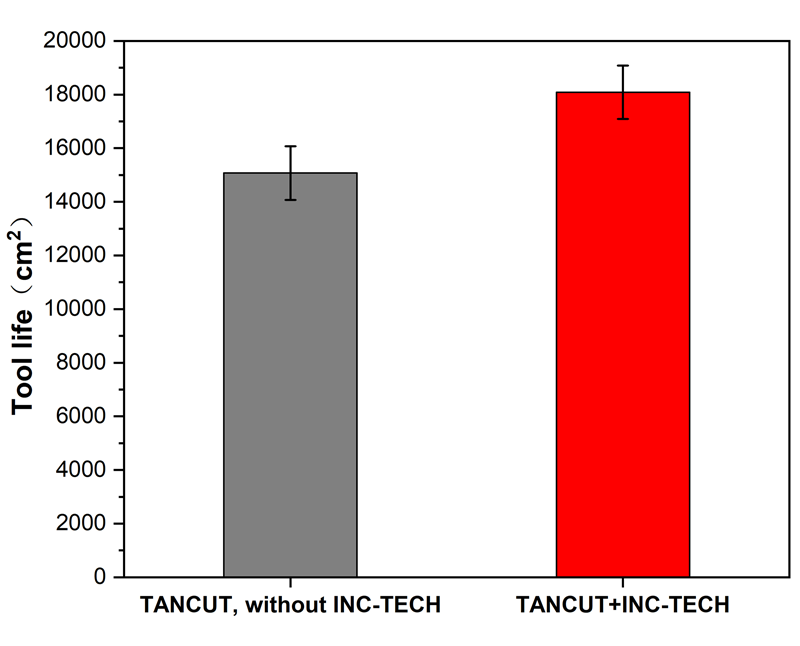
What is Coating? +
SHD:hard coating like SHIELD (SHD) to protect tooth.
The development of advanced processing technology (high-speed and high-efficient machining) and the wide application of the difficult-to-cut materials (such as hardened steels or nickel and titanium based aviation materials) have led to the rapid wear failure for both bi-metal and carbide bandsaw blades.The use of advanced coated tools prepared through physical vapor deposition (PVD) has been proved to be critical to realizing the benefits of high performance machining.
Facing the various machining conditions of the different processed materials,the Bichamp SHD TECHNOLOGY can provide advanced coating solutions based on the customers'demands.Just like the shield can protect the champion,when customers choose the Bichamp bandsaws with SHD TECHNOLOGY,they can benefit from the combination of high-quality bandsaws and high performance PVD hard coating:
a. Advanced manufacturing accuracy of bandsaw
b. Increased surface hardness of cutting tooth
c. Superior adhesion between the coating and the bandsaw
d. High toughness for interrupted cutting conditions of bandsaw
e. Reduced friction coefficient and heat of cutting
f. Limited formation of built-up-edge
g. The possibility of dry cutting
h. Extraordinary surface quality of the cross section
i. Big improvements in productivity
j. Great reductions in manufacturing organization costs
The Bichamp SHD coated bandsaws series consist of both bi-metal and carbide blades,the cutting parameters are different by vary applications.If you are searching for the solution for the difficult-to-cut materials machining or the cost containment,then you are welcome to contact our sales representatives or technical support for assistance.
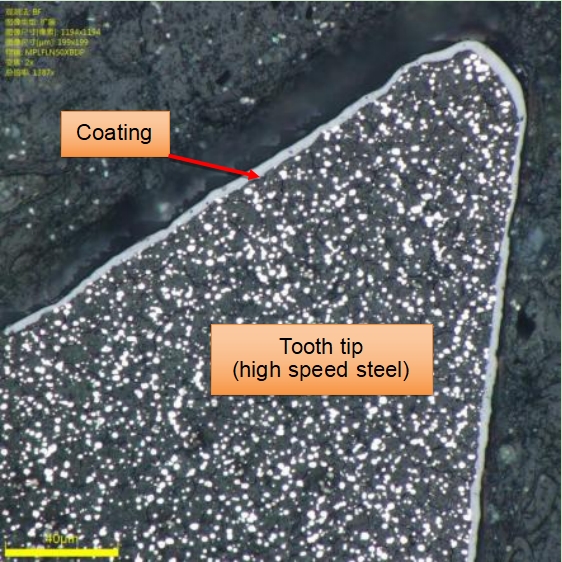
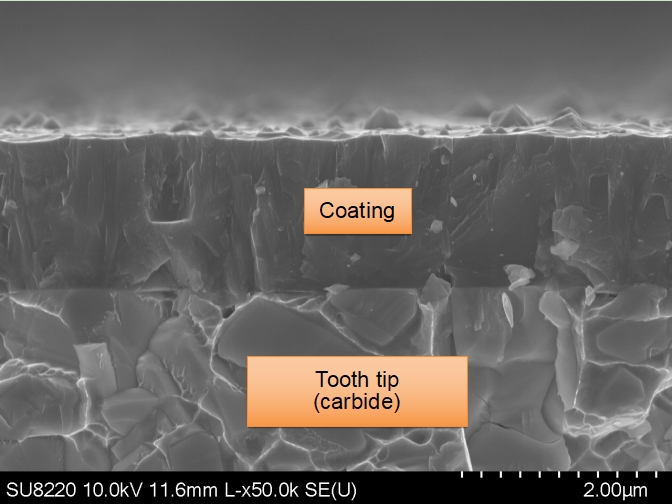
How to do the break-in? +
![]()
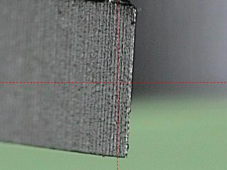 | 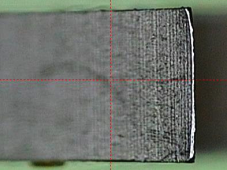 |  |
| Before break-in | After proper break-in | After improper break-in |
Tooth tips are very sharp and sometimes with some small burs from manufacturing. | Proper break-in makes blades gain a good tooth tip with small round cutting edge,which is beneficial for prolonging blade life. | Improper break-in results in disastrous chipping on tooth tips,which shortens blade life greatly. |
For bi-metal bandsaw blade:
1) Use the recommended band speed for the material you want to cut.
2) Reduce the feed rate with 30-40%.
3) Run the blade for 30-60 min and slightly increase the feed with every cut.
4) Set band speed and feed rate as normal.
For carbide bandsaw blade:
1) For the 1st cut,set feed and band speed parameters as for a bimetal.
2) For the second cut increase band speed,while avoiding vibration.
3) Then increase feed to match band speed while avoiding vibration.
4) Repeat second cut till you have reached normal parameter values for a carbide blade.
Steel grade | dimensionφ (mm) | 100 | 200 | 300 | 400 | 500 | 700 | 1000 |
Carbon steel/ Low alloy steel | Band speed (m/min) | 50-85 | 50-75 | 45-65 | 40-50 | 35-45 | 30-40 | 25-35 |
Efficiency (cm²/min) | 45-70 | 50-80 | 45-65 | 35-50 | 35-45 | 25-35 | 20-30 | |
Cr alloy steel/ Cr-Mo steel/ Ni-Cr-Mo steel | Band speed (m/min) | 50-65 | 50-60 | 45-55 | 40-50 | 35-45 | 30-40 | 20-30 |
Efficiency (cm²/min) | 30-50 | 40-48 | 35-42 | 30-40 | 28-36 | 22-32 | 16-25 | |
Mold steel/ Hot-work steel/ Cold-work steel/ Tool steel | Band speed (m/min) | 24-40 | 24-40 | 22-40 | 20-35 | 20-35 | 18-30 | 16-25 |
Efficiency (cm²/min) | 8-20 | 16-30 | 14-30 | 12-28 | 12-28 | 10-25 | 8-18 | |
Stainless steel | Band speed (m/min) | 40-50 | 35-45 | 35-40 | 28-35 | 25-32 | 20-28 | 18-25 |
Efficiency (cm²/min) | 20-30 | 28-35 | 26-32 | 20-30 | 18-25 | 15-22 | 10-18 |
· The chart is only for materials with hardness of 20HRc or 225HB.When hardness ~30HRc or 283HB,slow the speed to 70% of the recommended in the chart.
When hardness ~35HRc or 330HB,slow the speed to 60% of the recommended in the chart.Bi-metal is not suggestible for workpiece with hardness higher than 40HRc.
· Actually,bandsawing parameter is strongly affected by external factors like machine condition,materials,fluid,etc.So your experience is very important.
Steel grade | dimensionφ (mm) | 100 | 200 | 300 | 400 | 500 | 700 | 1000 |
Hard wood | Band speed (m/min) | 1200-1500 | 1200-1500 | 1200-1500 | 1200-1500 | 1200-1500 | ||
Efficiency (cm²/min) | 6500-7200 | 1800-2000 | 1800-2000 | 1500-1600 | 1500-1600 | |||
Aluminum alloy | Band speed (m/min) | 1200-1500 | 1500-2000 | 1500-2000 | 2000-2500 | 2000-2500 | 2000-2500 | 2000-2500 |
Efficiency (cm²/min) | 1000-1200 | 1000-1200 | 1000-1200 | 1400-1800 | 1400-1800 | 1400-1800 | 1400-1800 | |
Stainless steel | Band speed (m/min) | 25-30 | 25-30 | 25-30 | 25-30 | 25-30 | 25-30 | |
Efficiency (cm²/min) | 5.0-6.0 | 5.0-6.0 | 5.0-6.0 | 4.5-5.5 | 4.5-5.5 | 4.5-5.5 | ||
Case-hardened steel | Band speed (m/min) | 40-50 | 40-50 | 35-45 | 35-45 | 35-45 | ||
Efficiency (cm²/min) | 10-15 | 10-15 | 10-15 | 10-15 | 10-15 | |||
Titanium alloy | Band speed (m/min) | 30~45 | 30~45 | 30~40 | 30~40 | 25~35 | 25~30 | 20~25 |
Efficiency (cm²/min) | 14-18 | 14-18 | 14-18 | 12-16 | 12-16 | 10-14 | 10-14 | |
Superalloy | Band speed (m/min) | 25-30 | 25-30 | 20-25 | 20-25 | 20-25 | 20-25 | |
Efficiency (cm²/min) | 3.5-8 | 3.5-8 | 3.5-7 | 3.5-7 | 3.5-6 | 3.5-6 |
How to solve"Tooth chipping or broken"problem? +
Causes: | Solutions: |
1. Improper choice of cutting parameters. 2. Improper clamping of workpiece. 3. Improper choice of tooth profile or pitch. 4. Cut into original kerf after changing bandsaw. 5. Unstable hydraulic system. 6. Ineffective brush. 7. Unpurified workpiece. | 1. Adjust cutting parameters. 2. Adjust clamp. 3. Try other tooth profile or pitch. 4. Cut into a new kerf after changingbandsaw. 5. Check hydraulic system (oil level,sealing,etc.). 6. Adjust brush to be functional. 7. Change another workpiece. |
How to solve"Crack from gullet"problem? +
Causes: | Solutions: |
1. Too large tension. 2. Too tight side guide. 3. Excessively wom teeth. 4. Wheel womn too much. 5. Not in alignment of two wheels. | 1. Decrease tension. 2. Loosen side guide. 3. Change a new bandsaw. 4. Tuining wheel suface, or change a new wheel. 5. Adjust two wheels to be in alignment. |
How to solve"Crack from center of body"problem? +
Causes: | Solutions: |
1. Pre-guide wheel press bandsaw body abnormally. 2. Side guide worn abnormally. 3. Chip into gap between side guide and bandsaw. | 1. Decrease tension. 2. Loosen side guide. 3. Change a new bandsaw. 4. Turning wheel surface,or change a new wheel. 5. Adjust two wheels to be in alignment. |
How to solve"The early fracture of blade body"problem? +
Causes: | Solutions: |
1. The upper location block(wheel)with severe wear. 2. The break of back edge caused by the worn-out back up guide blocks. 3. The tension of bandsaw was too high. 4. The feed rate and feed pressure were too heavy. 5. The distance between the two guide arms was too long. | 1. Replace the new upper location block(bearing). 2. Replace the new backup guide blocks. 3. Decrease the tension of bandsaw. 4. Decreasethe feed rate and feed pressure. 5. Adjust the distance between the two guide arms. 6. Adjust the position of the wheels. |
How to solve"Abnormal wear of the tooth"problem? +
Causes: | Solutions: |
1. The distance between the screws of stop bar was unreasonable. 2. The feed speed(feed rate)was too high. 3. Unstable feed speed caused bythe break of the hydraulic feed control value. 4. The hard oxide impurity substances on the surface of the work piece. 5. The bandsaw was installed in the wrong direction. | 1. Readjust the distance between the screws of stop bar. 2. Choose the proper feed speed before cutting. 3. Check the sealing performance of hydraulic feed control valuebefore cutting. 4. Remove the hard oxide impurity substances on the surface of the work piece. 5. Install the bandsaw in the right direction. |
How to solve"Out of square"problem? +
Causes: | Solutions: |
1. The break-in process of new bandsaw was neglected,or the parameter was inappropriate. 2. The feed speed(feed rate)was too high. 3. Both side guide blocks were worn-out. 4. The bandsaw was not clamped appropriately byguide blocks. 5. The jam nuts of guide arms were loosened. 6. The tension force of bandsaw was small. | 1. Break in the bandsaw with appropriate paraineter. 2. Choose the proper feed speed. 3. Check the guide blocksbefore cutting. 4. The bandsaw is clamped appropriately byguide blocks. 5. The jam nuts of guide arms are tighten. 6. Adjust the tension force to demand value. 7. The guide arms are close enough to the work piece without hindering cutting process. |
How to solve"Blade stuck"problem? +
Causes: | Solutions: |
1. Low tensile force. 2. Worn belt drive causes to loosen. 3. Bandsaw speed too low and feeding rate too high. 4. Worn band wheels causes a mismatch with bandsaw. 5. Excessive material stress. | 1. Increase band tension. 2. Increase belt drive tension. 3. Appropriate increase bandsaw speed and reduce feeding rate. 4. Replace band wheels or Modify the actual required length of saw blade. 5. Set an oblique block driven at the incision. |
How to solve"Cannot cut into workpiece"problem? +
Causes: | Solutions: |
1. Band installed in the wrong direction. 2. Abnormal hydraulic feed system. 3. Improper break-in,early abnormal wear. 4. Improper saw type selection. 5. lproper feeding rate. | 1. Set band installed in the right direction. 2. Check the speed control valve and feed pressure valve status. 3. Break-in correctly. 4. Replace suitable type of saw blade. 5. Reduce feeding rate. |
How to solve"Coarse washboarding"problem? +
Causes: | Solutions: |
1. Guide block loosened. 2. Used a low tensile force. 3. Abnormal cutting vibration. | 1. Tight guide block. 2. Confirm hydraulic oil level,Increase band tension. 3. Reduce bandsaw speed. |